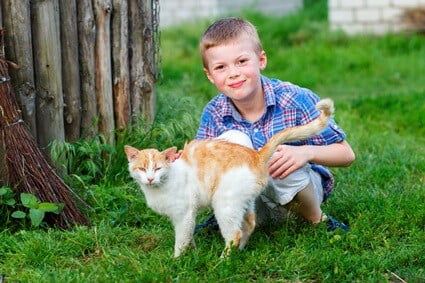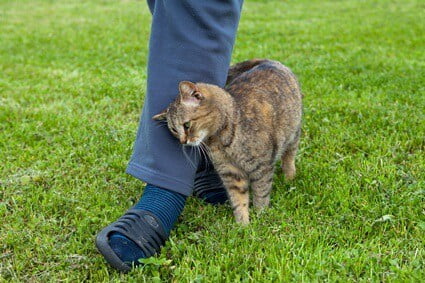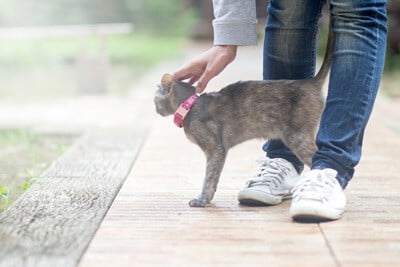Cats communicate through various body language and vocalizations. They use all methods of expression to send messages to humans, including meowing, purring, rolling over, rubbing against you, and arching their backs. However, it can be difficult to interpret these actions since they’re not human methods of communication.
When being petted, cats arch their backs to show affection, happiness, and contentment. The cat will likely raise its back and rub against you. It’s how cats ask for attention, greet you, and show pleasure. However, a cat may exhibit fear and aggression with this gesture, but you can tell the difference based on negative body language.
Cats that want your touch will lean into petting, and those that don’t will duck low to the ground and move away. Hissing, flattened ears, poofing up, and wide-eyed glaring can be signs of feline annoyance.
Why Do Cats Raise Their Backs When Petted?
According to Animal Cognition, cats that have healthy and trusting relationships with their owners will take emotional direction from them.
So, your cat may be interacting with new objects and people based on how you react to them. If you show fear, distrust, anxiety, or unhappiness when dealing with a situation or person, your cat’s behavior may reflect this.
This can provide insight into whether back arching is a positive or negative behavior. According to Anthrozoös, contentment is an interpretation agreed upon by 80% of non-professionals. However, knowing whether your cat is displaying a positive or negative reaction isn’t easy without other cues.
The other body language that the cat displays will tell you how it’s feeling, as can any sounds it makes while arching its back. For example, if the cat is purring while it arches its back, it’s feeling happy; if it’s hissing, it’s feeling displeasure.
The main explanation for this behavior include:
Stretching
Cats need to stretch out their muscles. If your cat arches after waking up from a nap, even when you pet it, it’s just working out the kinks in its spine.
Cats arching their backs to stretch may yawn, shake their head, or dig their claws into and knead what they sleep on.
Feeling Playful
A cat that’s arching its back because it’s feeling playful may have its tail pointing directly into the air.
The tail might move slowly from side to side, and the whiskers will be perky and stick out from the cat’s face. These are signs of alertness, indicating that the cat is excited and ready to play.
Aggressive
Of course, cats displaying aggression may also seem alert. A feline that’s arching its back in a negative way when it’s being petted will soon make its hostility known.
This will involve a scratch, bite, or speedy escape. The cat won’t quite lean into the touch but appear to be dipping its head low. It may even hiss at you.
Stressed Out
Cats may show signs that are like aggression when they’re stressed. This could be environmental stressors or a reaction to other household pets and animals.
Your cat might arch its back alongside showing its teeth, flattening its ears, assuming a rigid posture, and widening its eyes. If this is the case, stop petting the cat until it’s more relaxed.

What Does a Cat Arching Back and Rubbing Mean?
You may find cats curving their backs and rubbing against you.
In this case, the explanation is that the cat is reacting to the friction and pressure. It may be expressing enjoyment, but most likely, it’s moving to guide you (or itself) to a spot that needs a good scratch/rub.
Cats have sensitive skin, which is why you can get scratched if you push their fur in the wrong direction. The cat may only rub against you with a light touch or for brief instances.
Some owners misinterpret this as teasing as if the cat is trying to taunt you into picking it up. In most cases, it’s just that the cat is gauging exactly how much pressure it wants, and it would appreciate a delicate touch if you petted it.
If your cat is rubbing up against you with its body, or particularly its head, this is a prime indicator of love and affection, which doubles as a greeting.
It’s saying hello and letting you know that it’s pleased about your presence.
Cat Arching Back and Rubbing Against Objects
Cats are tactile and olfactory animals, so touch and smell are just as important to them as sound and sight.
So, it’s no surprise that cats rub against objects as a way to learn about them and communicate their intentions.
Assessing The Object Or Person
By rubbing against an object, cats pick up information about other animals that may have been around it.
They can even detect where the object has been. This allows the cat to better understand what the object is, if it’s allowed to play with it, and what it can expect from it.
For example, if you introduce a new toy, the cat may arch its back and rub against it with its face. This allows it to pick up a variety of scents and learn more.

Scent-Marking
Of course, a cat will rub against objects to deposit its scent. The sides of a cat’s head and face have scent glands that can be used to deposit its pheromones.
Cats do this to stake their claim for anything they deem useful or important. They’ll often do this to mark their territory and toys that they consider to be their own, warning off other animals.
Cat Purrs or Meows While Arching Its Back
If a cat meows or purrs while arching its back, it’s having a pleasurable experience.
It’s the main way a cat can show its contentment. Cats are unusually vocal animals, meowing for various reasons. If you’re still questioning why your cat is arching its back, a meow can easily sum things up.
By meowing while arching its back, the cat is trying to:
- Get attention
- Ask for food
- Signal distress
- Greet someone
- Signal a need
Meowing while being petted might signal happiness, excitement, or a desire for attention or food. Cats only meow at humans, not other animals.
However, if your cat meows constantly, it may be a sign that it’s in pain or distress. The cat could be trying to get your attention to let you know something is wrong.
Purring from a healthy cat is almost always a positive sign. According to the Journal of Zoology, it’s created by centrally driven laryngeal modulation of respiratory flow. The study found that purring is one of the most common ways for cats to show enjoyment and pleasure.
Most cats will show their contentment and pleasure when they arch their backs. That’s especially true when you’re petting them. As long as the cat doesn’t flatten its ears, move low to the ground, or make aggressive noises, you can be sure it’s feeling happy and contented.

